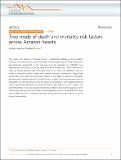Tree mode of death and mortality risk factors across Amazon forests
Abstract
The carbon sink capacity of tropical forests is substantially affected by tree mortality. However, the main drivers of tropical tree death remain largely unknown. Here we present a pan-Amazonian assessment of how and why trees die, analysing over 120,000 trees representing > 3800 species from 189 long-term RAINFOR forest plots. While tree mortality rates vary greatly Amazon-wide, on average trees are as likely to die standing as they are broken or uprooted—modes of death with different ecological consequences. Species-level growth rate is the single most important predictor of tree death in Amazonia, with faster-growing species being at higher risk. Within species, however, the slowest-growing trees are at greatest risk while the effect of tree size varies across the basin. In the driest Amazonian region species-level bioclimatic distributional patterns also predict the risk of death, suggesting that these forests are experiencing climatic conditions beyond their adaptative limits. These results provide not only a holistic pan-Amazonian picture of tree death but large-scale evidence for the overarching importance of the growth–survival trade-off in driving tropical tree mortality.
Citation
Esquivel-Muelbert , A , Phillips , O L , Brienen , R J W , Fauset , S , Sullivan , M J P , Baker , T R , Chao , K J , Feldpausch , T R , Gloor , E , Higuchi , N , Houwing-Duistermaat , J , Lloyd , J , Liu , H , Malhi , Y , Marimon , B , Marimon Junior , B H , Monteagudo-Mendoza , A , Poorter , L , Silveira , M , Torre , E V , Dávila , E A , del Aguila Pasquel , J , Almeida , E , Loayza , P A , Andrade , A , Aragão , L E O C , Araujo-Murakami , A , Arets , E , Arroyo , L , Aymard C , G A , Baisie , M , Baraloto , C , Camargo , P B , Barroso , J , Blanc , L , Bonal , D , Bongers , F , Boot , R , Brown , F , Burban , B , Camargo , J L , Castro , W , Moscoso , V C , Chave , J , Comiskey , J , Valverde , F C , da Costa , A L , Cardozo , N D , Di Fiore , A & Honorio Coronado , E 2020 , ' Tree mode of death and mortality risk factors across Amazon forests ' , Nature Communications , vol. 11 , 5515 . https://doi.org/10.1038/s41467-020-18996-3
Publication
Nature Communications
Status
Peer reviewed
ISSN
2041-1723Type
Journal article
Description
Funding Information: The analysis undertaken here was largely funded by the NERC-funded TREMOR project (NE/N004655/1) to D.G., R.J.W.B., E.G. and O.L.P. A.E.-M. was funded by TREMOR and by two ERC awards (T-FORCES 291585, TreeMort 758873). D.G. acknowledges further support from a Newton-funded consortium award (ARBOLES, NE/S011811/1). O.L.P. was supported by an ERC Advanced Grant and a Royal Society Wolfson Research Merit Award. T.A.M.P. was funded by the ERC award TreeMort 758873. This is paper number 47 of the Birmingham Institute of Forest Research. T.R.F., L.E.O.C.A. and O.L.P. were supported by NERC NE/N011570/1. Support for RAINFOR has come from the Natural Environment Research Council (NERC) Urgency Grants and NERC Consortium Grants AMAZONICA (NE/F005806/ 1), TROBIT (NE/D005590/1) and BIO-RED (NE/N012542/1), a European Research Council (ERC) grant T-FORCES (291585), the Gordon and Betty Moore Foundation (#1656), the European Union’s Seventh Framework Programme (282664, AMAZA-LERT) and the Royal Society (CH160091). This is paper #47 of the Birmingham Institute of Forest Research (BIFoR).Collections
Items in the St Andrews Research Repository are protected by copyright, with all rights reserved, unless otherwise indicated.

